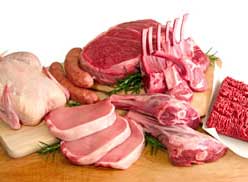Each person needs only 3-5 grams of iron, but if lacking, your health will suffer. For women, iron deficiency directly affects sexual development.
 |
| Iron from meat is more easily absorbed than from fruits and vegetables. (Photo: aboutorganics) |
During puberty, girls with iron deficiency exhibit negative effects not only in muscle development but also in psychological and intellectual growth. The bust measurement may not show significant changes, and the body shape can remain slender like that of a child, with signs of sexual maturity developing very slowly.
Once menstruation begins, iron is lost through menstrual blood each month. In pregnancy, childbirth, and breastfeeding, a woman’s body requires double the amount of iron compared to previous stages.
About 20% of the iron reserves will be depleted during breastfeeding. Therefore, the risk of weakness, hair loss, and decreased sexual desire in this group is 2-3 times higher than in the general population. Iron deficiency in the blood can also lead to an increased tendency to bleed.
The Role of Iron
Iron is involved in the synthesis of red blood cells. It aids in the transportation of oxygen to cells, ensuring their survival. Additionally, iron serves as a reserve of oxygen for muscles. It also plays a role in neutralizing foreign substances that invade the body, synthesizing prostate hormones, and maintaining immune function.
A crisis of iron deficiency can destroy the function of many organs and systems in the body, weaken self-protective abilities, and disrupt metabolic processes.
Iron is most effectively metabolized with the help of vitamin B12 and folic acid (vitamin B9); this enables timely and rapid blood production. Hence, B12 is also known as “the red vitamin.” During menstruation, doctors recommend that women supplement with these two vitamins along with a B-complex pill (commonly referred to as 3B) to ensure bodily balance. Pregnant women may be advised to double their folic acid intake (under medical supervision).
Warning Signs of Iron Deficiency
Dry, pale skin, peeling skin, hair, and nails that break easily or fall out.
Frequent fatigue, insomnia, dizziness, nausea, lack of motivation, frequent infections, inflammation, depression, apathy, and memory loss.
Blood tests revealing red blood cell counts below 12 g/l indicate the need for iron supplementation and nutritious foods, along with various vitamins.
Iron-rich foods (listed from highest to lowest content): Pork liver, cocoa powder, beef liver, peanuts, cashews, pears, chicken eggs, apples, cabbage, fish, and cow’s milk.
Note: The iron content in plant-based foods (vegetables, fruits) is 3-4 times harder to metabolize than iron from animal sources (meat).




















































